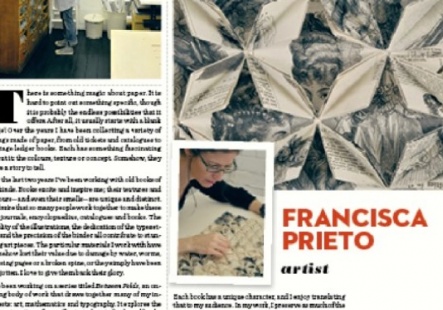Francisca Prieto featured in Uppercase
26/02/2012
Francisca Prieto featured in Uppercase
There is something magic about paper; it is hard to point out something specific, though it is probably the endless possibilities that it offers... It all starts with a blank page!
Over the years I have been collecting a variety of things made of paper and those things inspire me, from old tickets and catalogues to vintage ledger books and all kind of unusual finds. Each has something fascinating about them, the colours, texture, concept or simply because they make me smile. I choose them because I feel that somehow they have a story to tell.
For the last 2 years I have been working with old books. Books excite me and inspire me: the intimate relationship with their texture and colour and even their smell - all unique and distinct to each – ultimately feeds into the work. I have been working on a series entitled Between Folds, an ongoing body of work which draws together many of my interests: exploring the deconstruction of rare illustrated periodicals and books using modular structures whilst incorporating typographical elements. The delicate pages of these beautiful, often rare books are released from their bindings and restructured into new three-dimensional artworks. By dissecting, folding and re-connecting the pages, viewers are invited to experience looking at a book and all of its pages at once, yet without being able to read any one page individually.
I admire the dedication with which so many people work together into making these old journals, encyclopaedias, catalogues and books in general. The quality of their illustrations, the dedication with which the typesetter puts the text together, the precision of the binder, all contribute to create stunning art pieces. But the ones I work with have somehow lost their value due to damage by water, worms, missing pages, a broken spine, or they simply have been forgotten, so I love to give them back their glory.
Each book has a unique character and I enjoy translating that. I also like to keep as much of the book as possible, sometimes managing to use every single page, including the end papers and a bit from the cover. I like to keep any dedications, comments, fingerprints or other things that I find inside of them and that inform of their previous mysterious life.
Each leaf of the book is folded using a traditional origami technique, to form a single modular structure. Selected and folded in a planned and considered way so that the dominant image, be it a chair, a bird, or a musical score, relates to the connecting pieces forming a multilayered artwork made up of many tiny compositions. By consciously linking each module a hidden narrative emerges in each of my works through the conceptual connections, thus combining my interest as an artist, mathematician and typographer, whilst searching for precision and fluidity in each artwork.
Paper, as you can imagine, is quite fragile, so there are no mistakes allowed. You can easily tear it or leave a mark on it. Working with old, often rare books, I find that each page is irreplaceable, so I have to work very carefully. But the experience of transforming something very fragile into something totally new is what drives me. I just want people to look at them in detail and treasure them in a different way.

